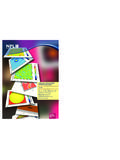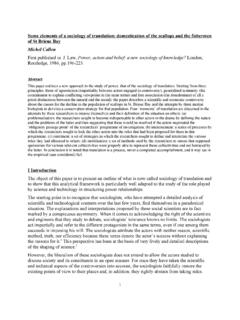Transcription of Fundamnetal good Practice in the design and Interpretation ...
1 GPG 79 & 80 6/12/05 9:29 am Page 1. A NATIONAL MEASUREMENT. GOOD Practice GUIDE. No. 79. Fundamental Good Practice in the design and Interpretation of engineering drawings for Measurement Processes GPG 79 & 80 6/12/05 9:29 am Page 2. The DTI drives our ambition of prosperity for all' by working to create the best environment for business success in the UK. We help people and companies become more productive by promoting enterprise, innovation and creativity. We champion UK business at home and abroad. We invest heavily in world-class science and technology. We protect the rights of working people and consumers. And we stand up for fair and open markets in the UK, Europe and the world. This Guide was developed by the National Physical Laboratory on behalf of the NMS. Measurement Good Practice Guide No. 79. Fundamental Good Practice in the design and Interpretation of engineering drawings for Measurement Processes David Flack engineering Measurement Team engineering and Process Control Division Keith Bevan Bevan Training and Assessment Services Limited ABSTRACT.
2 This good Practice guide is written for engineers, designers and metrology technicians who wish to understand the basics of the Interpretation of engineering drawings in relation to the measurement process. After reading this guide designers should have a better understanding of the measurement process and metrology technicians should be in a better position to interpret the aims of the designer. Crown Copyright 2005. Reproduced with the permission of the Controller of HMSO. and Queen's Printer for Scotland July 2005. ISSN 1368-6550. National Physical Laboratory Hampton Road, Teddington, Middlesex, TW11 0LW. Acknowledgements This document has been produced for the Department of Trade and Industry's National Measurement System Policy Unit under contract number GBBK/C/08/17. Thanks are due to Hexagon Metrology, Tesa Technology and Renishaw for providing some of the images and to Dr Richard Leach (NPL) and Prof. Paul Scott (Taylor Hobson) for suggesting improvements to this guide.
3 Contents 11. What this guide is about, and what it isn't?.. 12. Holistic approach to production .. 12. An introduction to Geometrical Product Specification .. 12. Interpreting a drawing in preparation for manufacture .. 16. Interpreting a drawing in preparation for measurement .. 17. The standard reference temperature .. 18. design .. 21. The designer's role an introduction to the modern design process utilising CAD, FEA. and mathematical 22. design Interpretation to make manufacturing and measurement 23. So why do dimensions require tolerances? .. 26. Measurement considerations when designing 26. Can I design the component to make measurement easier? .. 26. design changes to aid holding the 26. design changes to aid access to 27. design changes to allow repositioning to be used .. 27. Manufacture .. 29. An introduction to the manufacturing of 30. Overview of basic manufacturing and machining processes .. 31. Stock removal 31. Volume production processes .. 35. Monitoring the process.
4 35. Trend monitoring and statistical 36. Process control and measurement feedback .. 37. drawings .. 39. A simple overview of what information is being conveyed, for example, size, position, shape and surface 40. Introduction .. 40. Co-ordinate systems .. 40. General tolerances .. 41. Geometric tolerancing .. 41. Geometric references (datum features) .. 43. Feature control 45. Geometric characteristics .. 46. Form tolerances .. 47. Tolerances of location .. 50. Maximum material condition .. 51. Tolerances of 55. Tolerances of run-out .. 57. Surface 58. Establishing a co-ordinate system (datum) for a component .. 59. Can the datum be easily measured?.. 63. The virtual datum .. 63. Why is a partial arc a bad datum? .. 64. Measuring partial arcs on CMMs the problems .. 64. design consideration partial arcs .. 65. Does the tolerance really need to be that tight?.. 66. Least squares or minimum zone .. 66. 69. Ensuring that the components meet the 70. Sampling versus 100% 70.
5 Choosing the appropriate measurement tool .. 70. Is it possible to measure the dimensions specified on the drawing to ascertain if the tolerance has been met?.. 71. The importance of traceability .. 71. Uncertainty of measurement .. 73. Determining conformance with a specification - ISO 14253 decision 73. Summary of ISO 77. Published Standards .. 79. List of published 80. Glossary of terms .. 81. Glossary of 82. 85. Appendix A Links to other useful sources of information .. 86. National and International 86. National Physical 86. National Institute of Science and Technology (NIST).. 86. 86. Institute for Geometrical Product 87. Networks .. 87. Dimensional Metrology Awareness Club (DMAC).. 87. Software Support for Metrology Programme (SSfM).. 87. National and International Standards .. 87. British Standards Institution (BSI) .. 87. International Organisation for Standardization (ISO) .. 88. 88. National Measurement Partnership (NMP).. 89. Training courses .. 89. 90. Further reading.
6 92. Appendix B Further reading .. 93. Maximum material condition an 93. Statistical Process 94. Mean .. 94. Range .. 94. Standard deviation .. 94. Normal bell shaped curve .. 94. Histogram and control chart .. 95. 96. Six 97. List of Figures Figure 1 A typical manufactured component (Hexagon Metrology).. 13. Figure 2 The General concept of GPS tolerancing .. 14. Figure 3 The GPS tolerancing 15. Figure 4 A set of gauge blocks (Hexagon Metrology) .. 18. Figure 5 A co-ordinate measuring 18. Figure 6 design on a CAD system (Hexagon Metrology) .. 22. Figure 7 A typical drawing .. 23. Figure 8 A micrometer (Tesa Technology) .. 24. Figure 9 Callipers (Tesa Technology) .. 24. Figure 10 Bore gauges (Tesa Technology).. 24. Figure 11 A dial indicator (Tesa Technology).. 24. Figure 12 A roundness-measuring 25. Figure 13 A mounted 27. Figure 14 Attaching spheres allows repositioning to be 27. Figure 15 An item too big for the CMM being measured by repositioning (the white spheres are used for repositioning).
7 27. Figure 16 On-machine gauging (Renishaw) .. 31. Figure 17 On-machine gauging (Renishaw) .. 31. Figure 18 Gauging instrumentation (Tesa Technology).. 31. Figure 19 A typical 32. Figure 20 A typical milling machine .. 33. Figure 21 A typical wire cutting 34. Figure 22 Wire cutting in action .. 34. Figure 23 Inspecting a batch (Hexagon Metrology) .. 36. Figure 24 Basic control chart 37. Figure 25 Cartesian co-ordinate 40. Figure 26 Classification of geometrical 42. Figure 27 Overview of geometrical 43. Figure 28 Datum triangles and datum 44. Figure 29 Datum 44. Figure 30 Datum surface or feature extension of surface .. 45. Figure 31 Datum target frames .. 45. Figure 32 A feature control (tolerance) frame and the information it can contain .. 46. Figure 33 A simple feature control 46. Figure 34 Circularity (roundness) symbol .. 47. Figure 35 Circularity (roundness) definition .. 47. Figure 36 Straightness 47. Figure 37 Straightness definition .. 48. Figure 38 Flatness symbol.
8 48. Figure 39 Flatness definition .. 48. Figure 40 Cylindricity symbol .. 49. Figure 41 Cylindricity definition .. 49. Figure 42 Profile 49. Figure 43 Profile tolerance zones bilateral and uni-lateral .. 49. Figure 44 Line profile tolerance .. 50. Figure 45 Position 50. Figure 46 Cylindrical tolerance 51. Figure 47 The MMC symbol 51. Figure 48 The concept of maximum material 52. Figure 49 MMC example 53. Figure 50 Concentricity/co-axiality symbol .. 53. Figure 51 Concentricity 53. Figure 52 Symmetry feature control 54. Figure 53 Symmetry of a 54. Figure 54 Parallelism symbol .. 55. Figure 55 Example of a parallelism tolerance .. 55. Figure 56 Parallelism with cylindrical tolerance 55. Figure 57 Perpendicularity 56. Figure 58 Example of a perpendicularity 56. Figure 59 Example of a perpendicularity 56. Figure 60 Perpendicularity with a cylindrical tolerance zone .. 57. Figure 61 Angularity symbol .. 57. Figure 62 Angularity definition .. 57. Figure 63 Run-out symbol.
9 58. Figure 64 Run-out can be in the circular or axial direction .. 58. Figure 65 Total 58. Figure 66 Surface texture symbol .. 58. Figure 67 Measuring surface texture .. 59. Figure 68 A surface texture measuring 59. Figure 69 Aligning a component - exaggerated (Hexagon Metrology).. 59. Figure 70 Defining the axis of rotation (Hexagon Metrology).. 61. Figure 71 The affect of mis-alignment (Hexagon Metrology) .. 61. Figure 72 Creating a line to rotate about the z-axis (Hexagon Metrology) .. 62. Figure 73 Setting the origin (Hexagon Metrology) .. 62. Figure 74 A 3-2-1 63. Figure 75 A partial arc .. 64. Figure 76 Ten uniformly spaced measurements on a partial arc, showing the (nominal). circle of which it is part .. 65. Figure 77 A partial arc with a form 66. Figure 78 Traceability chain for gauge blocks .. 72. Figure 79 The two results and their 74. Figure 80 Uncertainty of measurement: the uncertainty range reduces the conformance and non-conformance zones (Copyright BSI extract from BS EN ISO 14253- 1:1999).
10 75. Figure 81 Conformance or 76. Figure 82 E-training via the NPL website .. 90. Figure 83 The introductory screen to the analogue-probing 90. Figure 84 The drawing requirements and actual measured values obtained .. 93. Figure 85 The calculations of the hole position both before and after the application of the MMC principle .. 93. Figure 86 Normal or bell shaped 95. Figure 87 A histogram .. 96. Figure 88 A control 96. 8 Preface Fundamental good Practice in the Interpretation of engineering drawings Preface The authors hope that after reading this Good Practice Guide you will be able to make better measurements of the size or shape of an object. The content is written at a simpler technical level than many of the standard textbooks on engineering design so that a wider audience can understand it. We are not trying to replace a whole raft of good textbooks, operator's manuals, specifications and standards, rather present an overview of good Practice and techniques.















